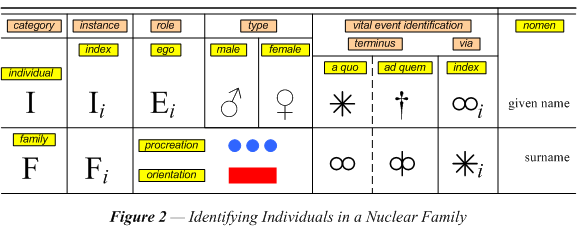
The symbols introduced above in the last section are not always fully adequate to point to specific individuals in their relationship to the nuclear family. In the case of individuals who relate to their family of orientation, they leave some ambiguity. To distinguish between the children additional identifiers must be appealed to. Figure 2 sets forth symbols for some of the various identifiers that we can add to the basic elements of figure 1.

The easiest way to distinguish two symbols is to assign them a subscript. This makes the sign refer to an instance, rather than a class. For the common relationship of spouse, however, it is often more convenient to use separate signs. I have chosen to signify these individuals using the traditional symbols for male (Mars) and female (Venus) respectively. These same signs can be used for children in one family who become spouses in another. The role of ego (E), i.e., “I, self” helps in stating kinship relationships, being used to refer to the person from whom the relationship is reckoned. On the far right we note that the name (nomen) is often the most distinctive way to distinguish children. In our culture the surname is a family name that all the children receive. In genealogy the vital events associated with each individual are probably an even more important distinguisher. The individual and the family both have beginnings and ends to their existence. These events are the birth (asterisk) and the marriage (double ring) to mark the beginning (a quo, i.e., “from which”) and the death (cross) and the disolution (double ring divided) to mark the termination (ad quem, i.e., “to which”). There are also vital events that mark points of time and place during or within the existence (via, i.e., “path”) of the individual and family. For an individual there are marriages that occur in life and for a family there are births of children that may occur during the family’s existence. Documentation of such auxiliary events constitutes good evidence that the individual, viz., family, existed — that it began before and ended afterwards.
